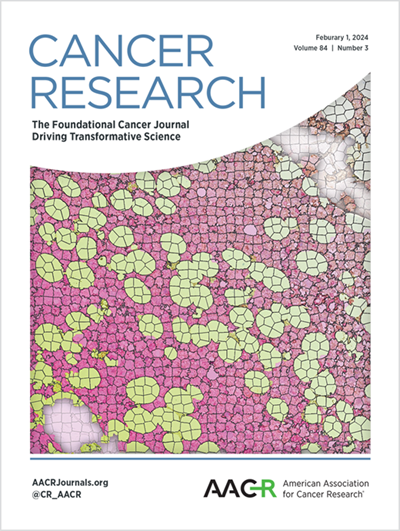TCTN1 Induces Fatty Acid Oxidation to Promote Melanoma Metastasis
IF 16.6
1区 医学
Q1 ONCOLOGY
引用次数: 0
Abstract
Metabolic reprogramming promotes and sustains multiple steps of melanoma metastasis. Identification of key regulators of metabolic reprogramming could lead to the development of treatments for preventing and treating metastatic melanoma. Here, we identified that the tectonic family member TCTN1 promotes melanoma metastasis by increasing fatty acid oxidation (FAO). In clinical melanoma samples, high expression of TCTN1 correlated with increased metastasis and shorter patient survival. Functionally, TCTN1 promoted melanoma invasion and migration in vitro and distant metastasis in vivo, and TCTN1 induced a mesenchymal-like phenotype switch. Mechanistically, TCTN1 acted as a protein scaffold to promote the binding of HADHA and HADHB, subunits of the mitochondrial trifunctional protein complex, thus leading to FAO activation. TCTN1-mediated FAO activated the p38/MAPK signaling pathway in melanoma cells, promoting tumor EMT and stemness. Molecular docking indicated that the prostaglandin F receptor agonist fluprostenol can block HADHA/HADHB binding, which was confirmed experimentally. Treatment with fluprostenol was able to inhibit TCTN1-induced melanoma invasion and metastasis. Taken together, these findings elucidate the mechanism of TCTN1-mediated promotion of melanoma metastasis and support the potential application of fluprostenol for targeted therapy of metastatic melanoma.TCTN1 诱导脂肪酸氧化促进黑色素瘤转移
代谢重编程促进并维持了黑色素瘤转移的多个步骤。确定代谢重编程的关键调控因子有助于开发预防和治疗转移性黑色素瘤的疗法。在这里,我们发现构造家族成员TCTN1通过增加脂肪酸氧化(FAO)促进黑色素瘤转移。在临床黑色素瘤样本中,TCTN1的高表达与转移增加和患者生存期缩短相关。在功能上,TCTN1促进了黑色素瘤体外的侵袭和迁移以及体内的远处转移,并且TCTN1诱导了间质样表型的转换。从机理上讲,TCTN1是一种蛋白质支架,可促进线粒体三功能蛋白复合物亚基HADHA和HADHB的结合,从而导致FAO活化。TCTN1 介导的 FAO 激活了黑色素瘤细胞中的 p38/MAPK 信号通路,促进了肿瘤的 EMT 和干性。分子对接表明,前列腺素F受体激动剂氟前列醇可以阻断HADHA/HADHB的结合,这一点在实验中得到了证实。氟前列醇能够抑制TCTN1诱导的黑色素瘤侵袭和转移。综上所述,这些发现阐明了TCTN1介导的促进黑色素瘤转移的机制,并支持将氟前列醇用于转移性黑色素瘤靶向治疗的可能性。
本文章由计算机程序翻译,如有差异,请以英文原文为准。
求助全文
约1分钟内获得全文
求助全文
来源期刊

Cancer research
医学-肿瘤学
CiteScore
16.10
自引率
0.90%
发文量
7677
审稿时长
2.5 months
期刊介绍:
Cancer Research, published by the American Association for Cancer Research (AACR), is a journal that focuses on impactful original studies, reviews, and opinion pieces relevant to the broad cancer research community. Manuscripts that present conceptual or technological advances leading to insights into cancer biology are particularly sought after. The journal also places emphasis on convergence science, which involves bridging multiple distinct areas of cancer research.
With primary subsections including Cancer Biology, Cancer Immunology, Cancer Metabolism and Molecular Mechanisms, Translational Cancer Biology, Cancer Landscapes, and Convergence Science, Cancer Research has a comprehensive scope. It is published twice a month and has one volume per year, with a print ISSN of 0008-5472 and an online ISSN of 1538-7445.
Cancer Research is abstracted and/or indexed in various databases and platforms, including BIOSIS Previews (R) Database, MEDLINE, Current Contents/Life Sciences, Current Contents/Clinical Medicine, Science Citation Index, Scopus, and Web of Science.
 求助内容:
求助内容: 应助结果提醒方式:
应助结果提醒方式:


